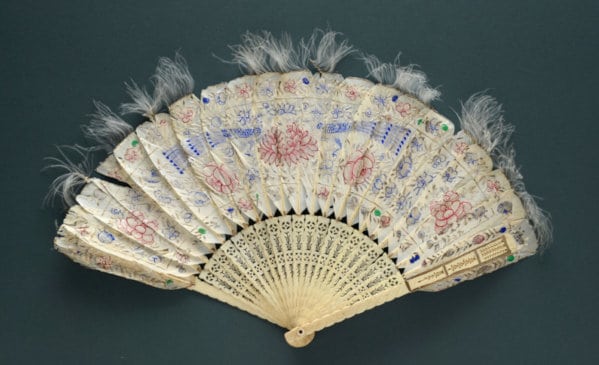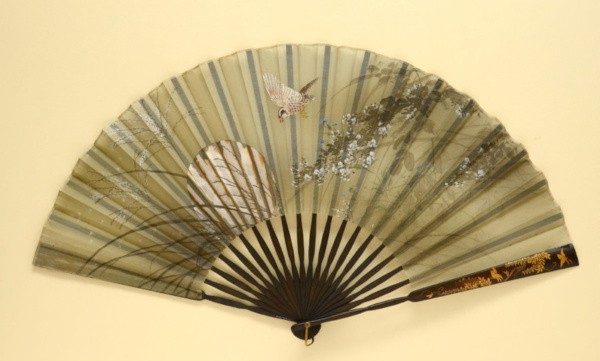From royalties to nobles to the poorest commoners, Chinese fans have been a very important part of ancient China and its history. They are, however, still very popular today not only in China and all over the world.
If you travel to China during the summer, you can easily see people in the street fanning away the striking heat. Even today, you can easily find Chinese fans in many peddlers and stores all across China.
The Chinese fan has over three thousand years of history and is certainly not only something you use to beat the heat. Here, we will learn all you need to know about Chinese traditional fans. Let us start by discussing its history.
History of Chinese Fans
The Chinese are well regarded as one of the first cultures who invented the fans, and archeologists have agreed that the oldest known Fan in Asia (from around the 2nd century BCE) originated in China, more exactly the Mawangdui tomb in Hunan Province.
This ancient fan is made of woven bamboo and is believed to be used by royalty when they traveled outdoors.
The history of Chinese fans can be traced back to more than 3,000 years ago, more exactly at the times of the Shang Dynasty (1600 to 1046 BCE).
However, this oldest type of fan is not yet handheld and used very differently. Named Shanhan, the “fan” was then tied to a horse carriage with the purpose of blocking the heat of the sun and also sheltering the carriage during the rain. So, technically the Shanhan is more alike today’s modern umbrella than the handheld Chinese fan we all know today.
With that being said, the Shanhan then evolved to be a long-handled fan called the Zhangshan, which is constructed from thin but durable feathers or silk fabrics. Back then, the Zhangshan was mainly used for decoration, and as a part of the emperor’s honor guard’s uniform.
The first Chinese fan that was finally used to create airflow and help cool down the heat was invented during the times of the Zhou Dynasty (1046-256 BCE), so, more than 2,000 years ago.
The Chinese fan back then was mainly made of feathers, and so they are called feather fans and are mainly popular among the rich and nobility (since it was extremely expensive to make one back then).
Click here to see some awesome Chinese Fan designs.– Aff.link

During the times of the Han Dynasty (206 BCE-220 CE), the fan became even more popular, especially when the more affordable bamboo fans and hand-woven cattail-leaf fans were invented, allowing common people to own and wield them.
The popularity of these fans continues until the Song Dynasty (960-1279 CE). Yet, a new type of silk fan was also invented back then. These silk fans are shaped round (to resemble the moon) and are called the “round fans” or tuánshàn 团扇. Due to their small size and simplicity, the round fan became popular, especially among younger females. These round fans, later on, took other shapes like the shape of sunflower or plum flower, and oval shapes.
The handle is engraved with beautiful patterns and designs and often incorporated jade pendants as its decoration, while the “face” is also often decorated with nature-inspired paintings like mountain scenery or flowers.
The ribs of the fan were made of mainly bamboo or animal bones. These silk round fans continued to be popular in ancient China for almost 1,000 years, which also contributes to the popularity of fan painting as an important art form in ancient China and even until today.
Nowadays, there are over 500 different types of fans in China, and some of them are widely valued worldwide.
Meaning of Chinese Fans
The meaning and value of Chinese fans have evolved according to the times. The silk round fan or tuánshàn, for example, is modeled after the full moon, with the full moon itself being the symbol of happiness and union in China.

Before then during the Zhou Dynasty, roughly 2,000 years ago, the Chinese fan was believed to symbolize wisdom and authority, with the feather fans mainly used by nobles.
In the times of the Song Dynasty, when Chinese fans became the norm for the common people, painting on the fan became very important, and as mentioned, fan painting became a popular art form on its own.
Paintings of birds and flowers, for example, symbolize beauty and gracefulness and became the favorite fan design for young women. Scholars, however, prefer fans decorated with calligraphy and depiction of ancient stories, which symbolize wisdom and knowledge.
Mythological creatures are also popular choices in fan painting. Dragons, for instance, are frequently depicted in men’s fans, while ladies generally prefer phoenixes.
In this modern times, however, the meaning and philosophy might not be as important as before, but some people and tourists might look for fans with specific designs that might symbolize a certain value or are believed to bring good luck.
Check out our “Free Culture Library“. We have compiled some great free resources, about Chinese culture, for your research.
Chinese VS Japanese Folding Fans
When we are discussing fans and especially handheld fans, the first thing that comes to mind might be the exquisite, paper-folding fans.
Today’s popular Chinese folding fan, however, is said to be influenced by Japan’s folding fan. The Japanese are said to have invented the first folding fan with the bat’s wings as their inspiration.
It is widely believed that the Japanese first invented the Akomeogi, the Japanese folding fan around the 6th century CE, and it was brought to China around the 7th or 8th century CE. During the Heian period in Japan, folding fans were commonly held by nobility and aristocrats as a part of their formal attire.
They were made by tying thin streaks of Japanese cypress (hinoki) together with a flexible thread. The number of wooden strips featured in the folding fan will differ according to the owner’s current rank.
The Japanese folding fans are still used today by Shinto priests and within the Japanese court, including by the Japanese Emperor and Empress during special occasions like weddings and coronations.
The Japanese folding fan, due to its function in symbolizing wealth and rank, can use various luxurious materials like the ox horn, mottled bamboo, ebony, jadeite, and even elephant trunk to construct the ribs. They might be carved into different shapes and the number of ribs can dictate the size of the folding fans, for instance, 7, 9, or 12.
In China, the folding fan became really popular during the times of the Ming Dynasty (1368-1644 CE), so it’s actually pretty recent. Back then, the city of Hangzhou was the center of folding fan manufacturing.

Today, folding fans are made in Rongchang of Chongqing municipality, but the history of Rongchang folding fans can be traced back to the Song Dynasty. Rongchang became one of the biggest folding fan producers in China during the reign of Ming Emperor Yongle (1402-1424), with over 10,000 folding fans being delivered from Rongchang to the imperial court every single year.
The Chinese folding fans are traditionally made of paper of silk, but other types of fabric or even flexible wood materials can be used.
Painting decoration remains one of the most important parts of the Chinese folding fan, and actually one of the easiest ways to differentiate between a Chinese and Japanese folding fan is to look at the painting on the face of the fan since Japan and China have distinct painting styles.
Click here to see some awesome Chinese Fan designs.– Aff.link
Types of Chinese Folding Fans
As with China’s rich culture, there are also many types of Chinese fans throughout Chinese history, and most of them are still widely available today. Here are some of the common ones:
Feather Fan
As the name suggests, this type of fan is made of bird feathers, and as discussed above, has been around since the time of the Zhou dynasty. Commonly used in the imperial place and among the aristocrats, widely recognized in ancient China as the symbol of wealth, authority, and wisdom.
Folding Fan
As previously discussed, the folding fan is mainly characterized by how it can fold to an easy-to-carry shape. Invented not by the Chinese, but by the Japanese, Folding fans were brought by trade to China around the 7th or 8th century CE, and went on to be an important part of the Chinese heritage.
They went on to be really popular, especially during the times of the Song and Ming dynasties.
Bamboo Fan
Also often known as the commoner’s fan, the invention of the bamboo fan is actually what enabled the common people in ancient China (non-nobility) to own and wear a fan.
Made popular during the times of the Han Dynasty (206 BC-220CE), bamboo fans are significantly more affordable than the older fans (like the ones made using animal bones for the fan’s ribs), and so are widely used in its time.
Silk Fan
Famous especially during the times of Southern and Northern Dynasties (420 – 589), where the silk was shaped to resemble the shape of the full moon and also called the “round fan” or tuánshàn.
Widely used in the imperial palace especially among young females due to its feminine design and shape.

Inscribed fan
Characterized by the inscribed calligraphy, number, or Mandarin character that can symbolize a specific meaning with each design. Commonly accepted as the symbol of knowledge and wisdom, and so is popular among scholars in ancient China.
Paper Fan
As the name suggests, made of paper and the outer side is layered with certain coatings (lacquer, oil) to protect the fan from water damage and make it more durable.
Palm-Leaf Fan
Relatively big and heavy, and traditionally features really long and heavy handle. Typically colored green to resemble, as you might have guessed, a palm leaf.
End Words
If you’ve spent a summer in China, it’s virtually impossible to miss people strolling down the roads with their handheld Chinese fans to beat the heat. However, the Chinese traditional fan is actually a very important part of Chinese culture, with over 3,000 years of history.
With its humble beginning in the times of the Shang Dynasty around 1,500 BCE, Chinese fans have stood the test of time and are still widely popular today not only in China but all over Asia and all around the world.
Related reading: Innovation Through the Ages: Unraveling the Timeline of Chinese Inventions – Opens in new tab
Stay in Touch
 Join our newsletter by using the forms on this website or click here!
Join our newsletter by using the forms on this website or click here! Follow us on Google News
Follow us on Google News Follow us on Facebook
Follow us on Facebook
Featured Photo by Quốc Bảo from Pexels





